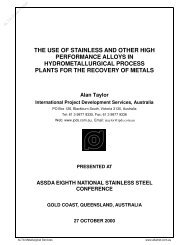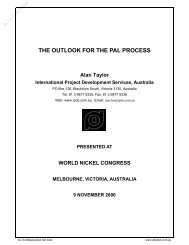solvent extraction mixer-settler design - ALTA Metallurgical Services
solvent extraction mixer-settler design - ALTA Metallurgical Services
solvent extraction mixer-settler design - ALTA Metallurgical Services
You also want an ePaper? Increase the reach of your titles
YUMPU automatically turns print PDFs into web optimized ePapers that Google loves.
<strong>ALTA</strong> Free Paper<br />
droplets, which can lead to entrainment losses. For auxiliary impellers for the second (or third) stage,<br />
standard up pumping low shear mixing types have generally been specified. In recent years the<br />
equipment supplier Lightnin has undertaken extensive hydraulic test and modelling work to compare<br />
different impeller types, out of which they have developed new pump-mix and auxiliary impeller<br />
<strong>design</strong>s, which have since been widely used. A significant outcome is their ability to select the<br />
recommended optimum <strong>design</strong> for each particular application, including the feed hole diameter and<br />
clearance between the impeller and the bottom of the mix box in the case of pump-<strong>mixer</strong>s. A vital part<br />
of mix box <strong>design</strong> is the minimisation of the head required to be developed by the pump-mix impeller.<br />
Although it has the great advantage of operating as a self-regulating device over a wide range of<br />
flowrates, the pump-<strong>mixer</strong> has a low head capability. Thus, the <strong>design</strong> head must be carefully<br />
estimated and specified to the impeller supplier before finalisation of the mix box <strong>design</strong>, in case<br />
adjustments are required.<br />
Settler Details<br />
The <strong>design</strong> settling area is generally specified from industry experience supplemented by testwork as<br />
appropriate. Specific settling area can typically vary from 2 to 6 m 3 /h/m 2 over a temperature range of<br />
10 to 40 0 C, and is affected by factors such as the type of extractant, extractant concentration, O/A ratio<br />
and the phase continuity. An important issue is the minimum operating temperature, as the phase<br />
disengagement rate is highly sensitive to temperature, particularly below 20 0 C. At the other extreme,<br />
the maximum temperature is determined by organic degradation considerations, and is typically<br />
around 40-45 0 C. The shape of the <strong>settler</strong> is determined by specifying a width based on an organic<br />
velocity within the range of 3-6 cm/sec, derived from industry experience. Above this range, there is a<br />
risk of excessive turbulence at the weirs, while lower velocities can result in uneven flow patterns<br />
across the <strong>settler</strong>. Designers vary in their practice but, from a cost point of view, it is usually<br />
advantageous to adopt a narrower <strong>settler</strong> to reduce the cost of the distributor, picket fence, weir boxes,<br />
interstage piping and roof. The authors have had consistent success at the upper end of the velocity<br />
range. Of course, the velocity is also dependent on the depth of the organic layer. This is usually set<br />
as low as possible to minimise the volume of the organic inventory, which is frequently a high cost<br />
item. It is commonly within the range of 150-300 mm, and can be varied by adjusting the height of<br />
the aqueous weir. The organic weir is normally fixed, and sets the overall static depth of liquid. The<br />
<strong>settler</strong> sidewall height is normally about 1m, which allows for a freeboard of around 200 mm, plus<br />
adequate depth for the dispersion band, aqueous layer, and a clearance under the aqueous weir in the<br />
range of 100-200 mm. Some <strong>design</strong>ers have opted for a slope down under the aqueous weir box in<br />
order to reduce the depth in the main portion of the <strong>settler</strong>. In some cases, the available site area can<br />
have an overriding effect on the shape of the <strong>settler</strong>s.<br />
Figure 2 shows an inlet distributor consisting of a full width launder fitted with a series of holes in the<br />
bottom. The authors have found this to be effective for “killing” the velocity of the incoming<br />
dispersion, and achieving a good distribution across the <strong>settler</strong> width. It may be advantageous to cover<br />
the centre portion of the launder to avoid splashing of solutions over the top into the <strong>settler</strong> and the<br />
environment above. A variation of this concept is the use of a HDPE pipe in lieu of the launder, which<br />
is particularly advantageous if the <strong>settler</strong> is lined with the same material. It is recognised that many<br />
other <strong>design</strong>s have been used. The distributor is followed by a conventional picket fence, consisting of<br />
two rows of slats mounted offset to force the liquids to go through several 90 0 direction changes on the<br />
way through, as illustrated in Figure 4. Because of the effective operation of the distributor, the fence<br />
can be of the low head type. As mentioned above, some <strong>design</strong>ers opt for no distributor; in which case<br />
the picket fence must be <strong>design</strong>ed for a higher pressure drop in order to achieve effective distribution.<br />
This type of fence is sometimes <strong>design</strong>ed as a chevron, which provides more stilling area immediately<br />
in front of the feed from the mix box. Typically, the inlet portion of the <strong>settler</strong>, with the distributor<br />
and picket fence, is regarded as part of the active <strong>settler</strong> area.<br />
In the <strong>design</strong> shown in Figure 3, the separated aqueous passes under the organic weir box on its way to<br />
the aqueous weir box. However, when a plastic lined construction is used for the <strong>settler</strong>, it may be<br />
preferable to use a “drop-in” one-piece weir box assembly, supported from the <strong>settler</strong> walls or from
















